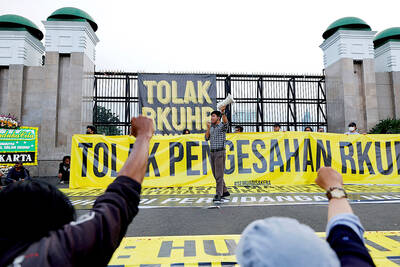"No women, no beer, no fiesta," a Peruvian mercenary said gloomily as he manned his post inside the Iraqi capital's ultra-protected Green Zone.
Around a thousand of his countrymen along with a handful of Chileans make up a security detail in this immense fortified sector of Baghdad, which houses the Iraqi government's offices and the US and British embassies.
The South Americans comprise a "third rung" of security, behind Iraqi regular soldiers and a unit of Georgians, members of the US-led coalition forces from the former Soviet republic.
The Peruvians are employed by the private US security firm Triple Canopy based in Virginia.
About a year ago, the Peruvians replaced the famed Nepalese Gurkhas who had served in the British army, but not because the South Americans were judged more competent. They replaced the Nepalese because they were cheaper.
A Western private security operative from a modern army -- such as an American, a Briton or a South African -- can earn US$8,000 to US$16,000 per month, one private security official said. The Gurkhas were earning around US$3,000 per month. The Peruvians earn about one-third of that.
Other firms employ Colombians, Mexicans or Panamanians. The South Americans, who are all former soldiers aged between 25 and 40, mostly come from poor, rural areas. Their missions last one year, with a break after six months for home leave.
In their position as the third line of defense, the Peruvians are not typically exposed to grave danger. Most have never left the Green Zone and some ask: "What's the Red Zone like?" in reference to the rest of Iraq.
Indeed, their primary enemy is the heat, as most are posted in exposed guard posts. Boredom is their other key enemy.
"There is nothing to do here," one man said.
"We watch television," said another. "But we'd like to be able to go out a bit at night."

Shamans in Peru on Monday gathered for an annual New Year’s ritual where they made predictions for the year to come, including illness for US President Donald Trump and the downfall of Venezuelan President Nicolas Maduro. “The United States should prepare itself because Donald Trump will fall seriously ill,” Juan de Dios Garcia proclaimed as he gathered with other shamans on a beach in southern Lima, dressed in traditional Andean ponchos and headdresses, and sprinkling flowers on the sand. The shamans carried large posters of world leaders, over which they crossed swords and burned incense, some of which they stomped on. In this

Indonesia yesterday began enforcing its newly ratified penal code, replacing a Dutch-era criminal law that had governed the country for more than 80 years and marking a major shift in its legal landscape. Since proclaiming independence in 1945, the Southeast Asian country had continued to operate under a colonial framework widely criticized as outdated and misaligned with Indonesia’s social values. Efforts to revise the code stalled for decades as lawmakers debated how to balance human rights, religious norms and local traditions in the world’s most populous Muslim-majority nation. The 345-page Indonesian Penal Code, known as the KUHP, was passed in 2022. It

Near the entrance to the Panama Canal, a monument to China’s contributions to the interoceanic waterway was torn down on Saturday night by order of local authorities. The move comes as US President Donald Trump has made threats in the past few months to retake control of the canal, claiming Beijing has too much influence in its operations. In a surprising move that has been criticized by leaders in Panama and China, the mayor’s office of the locality of Arraijan ordered the demolition of the monument built in 2004 to symbolize friendship between the countries. The mayor’s office said in

‘TRUMP’S LONG GAME’: Minnesota Governor Tim Walz said that while fraud was a serious issue, the US president was politicizing it to defund programs for Minnesotans US President Donald Trump’s administration on Tuesday said it was auditing immigration cases involving US citizens of Somalian origin to detect fraud that could lead to denaturalization, or revocation of citizenship, while also announcing a freeze of childcare funds to Minnesota and demanding an audit of some daycare centers. “Under US law, if an individual procures citizenship on a fraudulent basis, that is grounds for denaturalization,” US Department of Homeland Security Assistant Secretary Tricia McLaughlin said in a statement. Denaturalization cases are rare and can take years. About 11 cases were pursued per year between 1990 and 2017, the Immigrant Legal Resource